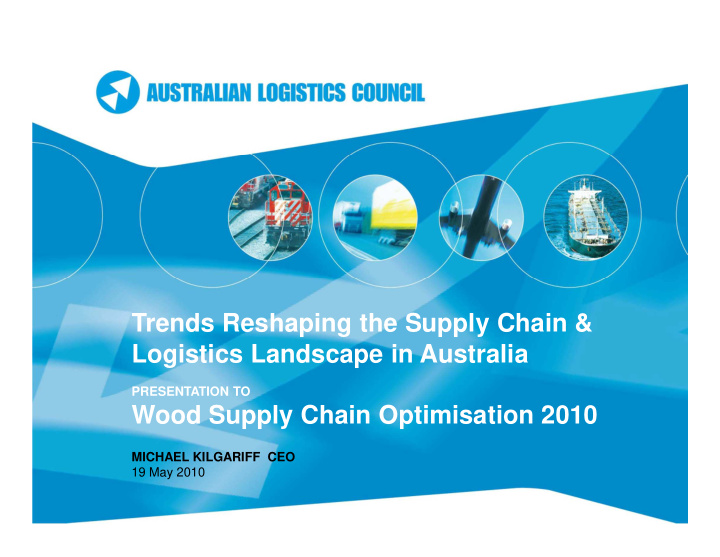



Trends Reshaping the Supply Chain & Logistics Landscape in Australia PRESENTATION TO Wood Supply Chain Optimisation 2010 MICHAEL KILGARIFF CEO 19 May 2010
ALC Mission Statement The Australian Logistics Council (ALC) is the peak national body for Australia’s freight Transport & Logistics (T&L) industry. Aim The aim of ALC is to influence government policy decisions to ensure that Australia enjoys a safe, secure, reliable, sustainable and competitive freight T&L industry.
Strategic Objectives 1. Be the nationally recognised voice of the major participants in Australia’s freight T&L supply chains. 2. Support appropriate nationally consistent regulatory frameworks and transparent markets to ensure Australia enjoys the full benefits of national freight T&L policy development and reform. 3. Promote the freight T&L industry’s image and profile and encourage greater recognition by governments and the community of the importance of the industry’s contribution to Australia’s economy. 4. Drive implementation of strategies to improve Australia’s supply chains.
Economic Positioning The Bureau of Transport Economics (BTRE) has defined logistics as: “the activities required for the movement and handling of goods and materials, from inputs through production to consumers and waste disposal”.
Economic Positioning of Freight T&L •Generates 14.5% of Australia’s GDP. •provides more than 1 m jobs across 165,000 companies. Treasury estimates that Australia’s population will increase to 35 million by 2050. Australia’s freight task has more than doubled over the last 20 years, is expected to almost double again by 2020, and triple by 2050.
Policy Issues Shaping the Trends 1. The national transport regulatory policy framework being developed by the Council of Australian Governments (COAG) and the Australian Transport Council (ATC). 2. The National Freight Network Plan, National Port Strategy, and National Transport Policy Framework
COAG Transport Reform December 2009 COAG meeting agreed to: • A National rail safety regulator in Adelaide. • A marine safety authority in Canberra. • A National Heavy Vehicle Regulator in Brisbane. The regulatory framework is to be in place by 2013. COAG also agreed to: • Examine various models of road pricing and funding. • National criteria for capital city strategic planning systems.
Prime Minister Rudd – January 2010 “In 2010 the transport priority for the Council of Australian Governments will be freight transport”. And freight “will require a massive effort – companies will have to improve transport and logistics strategies and efficiencies, and governments will have to undertake substantial new investment and policy reform”.
National Freight Network Plan . • Function is to ensure the regulatory environment, infrastructure and investment are in place to meet Australia’s freight needs. • Should not be a process of ‘picking winners’ • nor should freight be directed towards specific transport modes, ie the road vs rail debate. • Role is to ensure the estimated freight task anticipated at a given time in the future (say 20 years) can be met.
Nationally Significant Infrastructure • Should have regard to the size and importance of the infrastructure to the national economy. • Should include inland ports or intermodal facilities. • Victorian “Shaping Melbourne’s Freight Future Discussion Paper” • proposes to develop a network of intermodal freight terminals across Melbourne .
Nationally Significant Infrastructure ALC supports a National Partnership Agreement to: • Establish nationally significant infrastructure. • Ensure land use decisions prioritise nationally significant infrastructure. • Create a fund for state and local governments which incur expense as a result of making land-use decisions that favour nationally significant infrastructure
Transport & Logistics companies are high users of existing and new information. The ideal Logistics System smoothly delivers goods: •where they are needed, •when they are needed, •with the least amount of cost, energy, carbon, pollution, noise, congestion and harm. All T&L modes (road, rail, sea and air) must be able to work together to maximise efficiencies.
ALC January 2010 White Paper A Smarter Supply Chain - Using Information and Communications Strategy to Increase Productivity in the Australian Transport and Logistics Industry. Impartial industry wide ICT solutions for collaborative information sharing enhances the transport and logistics industry’s ability to deliver predictable and reliable transactions.
National Heavy Vehicle Framework Will administer a: • National heavy vehicle registration scheme, established under Commonwealth law. • Consistent approach to minimum standards for heavy vehicle driver competency and testing and to heavy vehicle driver training school recognition. • Single physical national heavy vehicle driver license.
Chain of Responsibility ALC supports as part of the framework for national heavy vehicle regulation: • A nationally consistent approach to CoR laws. • Appropriate industry driven compliance measures. • National Transport Commission model Road Transport Reform Bill. ALC has developed: • National Logistics Safety Code (NLSC) • Retail Logistics Supply Chain (RLSC) Code of Conduct.
Freight Australia • Infrastructure needed to meet the freight task. • Infrastructure of national significance. • How intermodal facilities can be developed. • Identifying blockages affecting the transport and logistics chain. • Advice to Infrastructure Australia on funding. • Encouraging the transfer of non proprietary information across the transport and logistics chain. • Acting as a ‘champion’ for the logistics industry to Government.
Making 2010 the “Year of Freight Transport” • Development of the national heavy vehicle regulatory framework. • National consistency of CoR laws. • A national, holistic regulatory framework across all modes and nodes of freight transport. • Land-use decisions that advance the freight effort over other possible land uses. • Improve the transfer of information along the T&L supply chain. Thank You
Recommend
More recommend